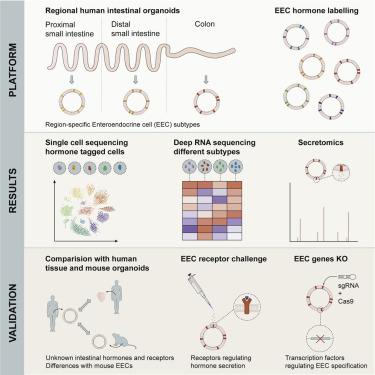Cell ( IF 45.5 ) Pub Date : 2020-05-13 , DOI: 10.1016/j.cell.2020.04.036 Joep Beumer 1 , Jens Puschhof 1 , Julia Bauzá-Martinez 2 , Adriana Martínez-Silgado 1 , Rasa Elmentaite 3 , Kylie R James 3 , Alexander Ross 4 , Delilah Hendriks 1 , Benedetta Artegiani 1 , Georg A Busslinger 1 , Bas Ponsioen 5 , Amanda Andersson-Rolf 1 , Aurelia Saftien 1 , Charelle Boot 1 , Kai Kretzschmar 1 , Maarten H Geurts 1 , Yotam E Bar-Ephraim 1 , Cayetano Pleguezuelos-Manzano 1 , Yorick Post 1 , Harry Begthel 1 , Franka van der Linden 6 , Carmen Lopez-Iglesias 7 , Willine J van de Wetering 8 , Reinier van der Linden 1 , Peter J Peters 7 , Albert J R Heck 2 , Joachim Goedhart 6 , Hugo Snippert 5 , Matthias Zilbauer 9 , Sarah A Teichmann 10 , Wei Wu 2 , Hans Clevers 11

|
Enteroendocrine cells (EECs) sense intestinal content and release hormones to regulate gastrointestinal activity, systemic metabolism, and food intake. Little is known about the molecular make-up of human EEC subtypes and the regulated secretion of individual hormones. Here, we describe an organoid-based platform for functional studies of human EECs. EEC formation is induced in vitro by transient expression of NEUROG3. A set of gut organoids was engineered in which the major hormones are fluorescently tagged. A single-cell mRNA atlas was generated for the different EEC subtypes, and their secreted products were recorded by mass-spectrometry. We note key differences to murine EECs, including hormones, sensory receptors, and transcription factors. Notably, several hormone-like molecules were identified. Inter-EEC communication is exemplified by secretin-induced GLP-1 secretion. Indeed, individual EEC subtypes carry receptors for various EEC hormones. This study provides a rich resource to study human EEC development and function.
中文翻译:

人类肠内分泌细胞的高分辨率 mRNA 和分泌组图谱。
肠内分泌细胞 (EEC) 感知肠道内容物并释放激素来调节胃肠道活动、全身代谢和食物摄入。人们对人类 EEC 亚型的分子组成和个体激素的分泌调节知之甚少。在这里,我们描述了一个基于类器官的人类 EEC 功能研究平台。 EEC 的形成是通过NEUROG3的瞬时表达在体外诱导的。设计了一组肠道类器官,其中主要激素被荧光标记。针对不同 EEC 亚型生成了单细胞 mRNA 图谱,并通过质谱记录了它们的分泌产物。我们注意到与小鼠 EEC 的关键差异,包括激素、感觉受体和转录因子。值得注意的是,鉴定出了几种激素样分子。 EEC 间的通讯以促胰液素诱导的 GLP-1 分泌为例。事实上,各个 EEC 亚型携带各种 EEC 激素的受体。这项研究为研究人类 EEC 的发育和功能提供了丰富的资源。











































 京公网安备 11010802027423号
京公网安备 11010802027423号